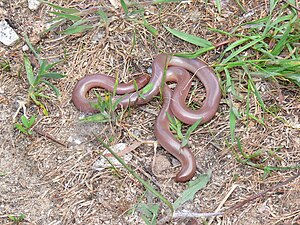Stupid eyes
| Stupid eyes | ||||||||||||
|---|---|---|---|---|---|---|---|---|---|---|---|---|

Dumb-eye ( Xerotyphlops vermicularis ) |
||||||||||||
| Systematics | ||||||||||||
|
||||||||||||
| Scientific name | ||||||||||||
| Xerotyphlops vermicularis | ||||||||||||
| ( Merrem , 1820) |
The stupid eye ( Xerotyphlops vermicularis , Syn. : Typhlops vermicularis ), like many other species of the genus Xerotyphlops often only as worm snake or European worm snake called, is a kind from the family of blind snakes (Typhlopidae) provided on the Balkans , in South-West Asia and Northeast Africa is common.
features
The dumb eye reaches a length of 18 to 30 centimeters. In its shape it is worm-like with a blunt head that is not detached from the body. The body is completely occupied by small, smooth scales, which are constructed in the same way all around. The abdominal scales are not designed as elongated abdominal rails, the tail ends in a thorn-like tail scale that serves as a "follower" when moving. At the head end the snake has two small and black eyes, the rest of the body is pink. The belly is slightly lighter than the back and translucent, so that the internal organs as well as eggs and food remains are visible.
distribution and habitat
The idiot lives in southeastern Europe in the Balkans from southwestern Montenegro via Albania , Macedonia and southern Bulgaria to Greece , also in northeastern Egypt , in Transcaucasia and in southwestern Asia. In Croatia there is a presumably allochthonous occurrence on the island of Dugi Otok off Zadar . The species can be found in flat and hilly areas and on dry slopes, especially in areas with loose, herbaceous vegetation.
Way of life
The snake is adapted to a purely underground way of life. It lives in underground corridors and under stones. It only comes to the surface in exceptional cases, especially during continuous rainfall, at dusk or at night. Depending on the altitude and temperature, it hibernates for two to six months. In the south of Greece ( Peloponnese ), however, it can also be active all year round.
The food of the Blödauge consists mainly of ants and their pupae and eggs, and it also eats other insects living underground, as well as millipedes and worms. The females lay four to eight elongated eggs for reproduction.
literature
- Ulrich Gruber: The snakes in Europe and around the Mediterranean . Franckh'sche Verlagsbuchhandlung, Stuttgart 1989, ISBN 3-440-05753-4
- Benny Trapp: Amphibians and reptiles of the Greek mainland. Natur und Tier - Verlag, Münster 2007, pp. 170–173. ISBN 3-86659-022-9
